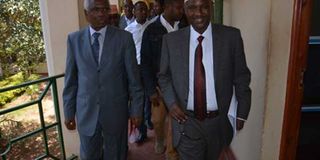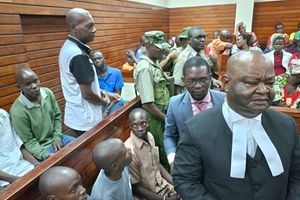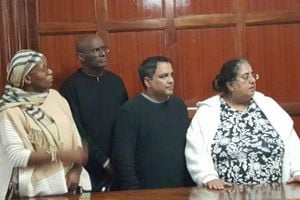Isiolo leaders want Lapsset corridor rerouted to avoid areas prone to land conflicts

Lapsset Corridor Development Authority chairman Francis Muthaura (left) and Isiolo Governor Godana Doyo after a consultative meeting on the Lapsset project on September 27, 2016. Isiolo leaders proposed the re-routing of the Lapsset corridor to avoid conflict zones. PHOTO | VIVIAN JEBET | NATION MEDIA GROUP
What you need to know:
- The corridor was designed to pass through Garba Tula-Kulamawe-Ngaremara (near Isiolo Town) towards Lokichar and Marsabit.
- The leaders further faulted the government for failure to consult them before mapping.
- Isiolo is the main hub that connects the standard gauge railway to Uganda, Ethiopia and South Sudan.
- Muthaura and Kasuku denied claims of a conspiracy by Mt Kenya leaders to divert all projects to their region.
The Isiolo County government wants the Lamu Port-South Sudan-Ethiopia Transport (Lapsset) corridor that traverses the county to be rerouted to avoid conflict-prone areas along the Meru-Isiolo border.
Governor Godana Doyo has proposed that the new route pass through Garba Tula, Boji and directly link to Lodwar through Merti and, by extension, to Ethiopia.
The corridor was designed to pass through Garba Tula-Kulamawe-Ngaremara (near Isiolo Town) towards Lokichar and Marsabit.
Addressing a meeting attended by county government officials and the Lapsset Corridor Development Authority (LCDA) on Tuesday, Mr Doyo suggested that the government should consider having an additional airport, dry port, resort city, oil refinery and rail station along the proposed new route.
At the same time, Isiolo County Assembly Speaker Mohammed Tubi accused the government of pushing infrastructural projects, including an international abattoir, resort city, international airport and the Lapsset corridor to the western side of the county.
LAND CONFLICTS
“Why did the authority divert the project from its central point in Kulamawe to pass through Isiolo Town where there are rampant land wrangles yet it could have gone through Isiolo North towards Ethiopia which is shorter?” wondered Mr Tubi.
“In order to minimise conflicts and other negative effects, we request that the Lapsset implementing authority re-routes the corridor. We have plenty of land and are planning to set aside the required space,” said Governor Doyo.
The leaders further faulted the government for failure to consult them before mapping and instead pushing all projects to the western side of Isiolo which borders Mt Kenya.
Isiolo is the main hub that connects the standard gauge railway to Uganda, Ethiopia and South Sudan.
Governor Doyo said the new route will be cost effective, enhance eco-tourism and open up the northern rangeland for development.
ENVIRONMENTAL IMPACT
In their arguments, the leaders said the proposed Isiolo resort city in Kipsing will have serious conservation impact on wildlife-protected area since it is near Buffalo, Samburu and Shaba national reserves.
“Isiolo International Airport is one of the Lapsset projects which nears completion. No environmental impact assessment was carried out before implementation. We are afraid that [the] Lapsset corridor will have a negative impact on conservation,” said Mr Doyo.
The mega project is expected to open up Kenya’s northern frontier to more trade and investments.
Initially, residents of Isiolo had raised concerns over lack of consultation on the venture, demanding that the government compensates them before embarking on the Vision 2030 flagship project.
The huge infrastructure projects entails international airports, an oil pipeline, oil refinery and three resort cities in Lamu, Isiolo and Turkana.
LCDA chairman Francis Muthaura, who was accompanied by director-general Silvester Kasuku, said the project aims at solving infrastructure deficit in northern Kenya.
The two denied claims of a conspiracy by Mt Kenya leaders to divert all projects to their region.
Mr Kasuku told the leaders to present their proposals detailing the proposed locations for assessment.
“We have already mapped the corridor, but our strategic environmental team will visit the proposed areas for assessment before finalising our plans,” said Mr Kasuku.





